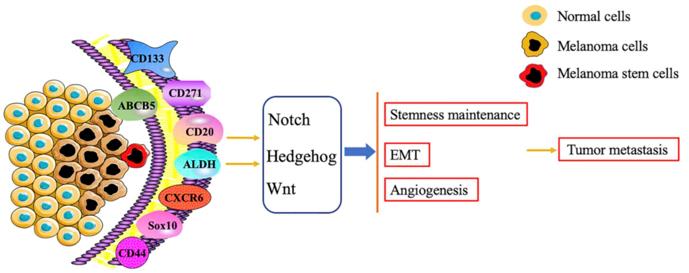Melanoma Cancer Stem Cell Markers
Overview of Melanoma Cancer Stem Cell Markers
Melanoma cancer stem cell markers are a crucial group of indicators that function prominently in melanoma (as in Fig.1), specifically targeting and identifying melanoma cancer stem cells. These stem cells possess the remarkable ability to self-renew and generate various mature cell types, potentially fostering regenerative abilities and promoting melanoma's metastatic capacity. The investigation of these melanoma cancer stem cell markers by researchers has yielded noteworthy advancements, thereby enhancing our comprehension of melanoma development, refining treatment outcomes, and paving the way for therapeutic interventions.
 Fig.1 Melanoma stem cell markers. Melanoma stem cells account for only a small part of melanoma cells, which express a variety of cell markers, such as CD133, ABCB5, CD271, CD20, CXCR6, Sox10, CD44, and ALDH. (Yin Q, et al., 2021)
Fig.1 Melanoma stem cell markers. Melanoma stem cells account for only a small part of melanoma cells, which express a variety of cell markers, such as CD133, ABCB5, CD271, CD20, CXCR6, Sox10, CD44, and ALDH. (Yin Q, et al., 2021)
Research Areas of Melanoma Cancer Stem Cell Markers
Research on melanoma cancer stem cell markers has focused on several areas.
- First, scientists have worked to identify and characterize specific proteins and molecular markers associated with melanoma cancer stem cells. The discovery of these markers is important for early diagnosis, pathologic analysis, and predicting patient outcomes.
- Second, the researchers also explored the signaling pathways that influence the self-renewal and proliferation of melanoma cancer stem cells, as well as the microenvironmental factors involved in generating and maintaining cancer stem cells.
- Finally, scientists seek to utilize melanoma cancer stem cell markers to develop new therapeutic strategies, such as targeted therapies and immunotherapies, to more effectively block melanoma cancer growth and metastasis.
Research Techniques for Melanoma Cancer Stem Cell Markers
To study melanoma cancer stem cell markers, researchers have used a variety of methods and techniques.
- Flow cytometry is a commonly used technique to isolate different subpopulations of cells based on the expression levels of surface markers. By using antibody staining against specific markers, researchers can accurately detect and isolate melanoma cancer stem cells to further study their properties and functions.
- Immunocytochemical staining and immunohistochemical staining techniques are used for the localization and detection of melanoma cancer stem cell markers.
- Real-time quantitative PCR (qPCR) is used to accurately measure differences in the expression of specific proteins or genes in stem cell and non-stem cell populations.
- The role of melanoma cancer stem cell markers in tumor development and metastasis can be explored using techniques such as gene knockdown, overexpression, or disruption of specific signaling pathways.
In conclusion, the study of melanoma cancer stem cell markers has an important role in revealing the mechanisms of tumor development and metastasis. By identifying and studying these markers, we can better understand the biological properties and pathogenic mechanisms of melanoma cancer stem cells and provide a basis for developing more effective therapeutic strategies. With the continuous advancement of technology and in-depth research, we expect to make more important discoveries about melanoma cancer stem cell markers in the future.
Reference:
- Yin Q, Shi X, Lan S, Jin H, and Wu D: Effect of melanoma stem cells on melanoma metastasis (Review). Oncol Lett 22: 566, 2021


